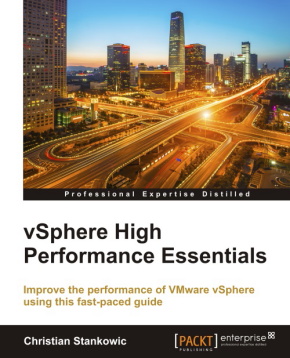vSphere High Performance Essentials
New year, new book - some of you might have noticed it: in the last couple of weeks, there were not much updates on my blog. The reason is that I have been working on a second book project. This time I had the pleasure to work as main author on a book about VMware vSphere. Last year, I have already been working as co-author on VMware vSphere Essentials.
While the first book was an introduction to VMware vSphere, the new book focuses on high-performance virtualization - which also complements the first book. The title is vSphere High Performance Essentials and can be purchased on multiple platforms - including:

PacktPub (publisher): [click me!]
- Amazon: [click me!]
- Google Play
- iBooks Store: [click me!]
ISBN: 9781783551699
Pages: 248
You can get the book 50% off until 05/30/2016 - simply use the following promo code: AUTWB50vps
Content
The book focuses on planning, configuring and monitoring virtual infrastructures in order to meet high performance requirements by implementing end-to-end optimzations (hardware, infrastructure, VMs). The following topics are discussed in 9 chapters:
- Hardware Design Concepts and Best-Practices - CPU market overview (Intel/AMD, cores, threads, Hyper-Threading), memory types, server types (tower, rack, blade), hyper convergence, storage types (HDDs, SSDs, SSHDs), SAN/NAS shared storage (FC/FCoE/iSCSI/NFS), VMware vSphere® Storage APIs, Virtual SAN, network configurations, NIC features, example scenarios
- Cluster Optimization Approaches - Scale up/Scale out principles, cluster introduction, understanding and optimizing resource pools, optimizing Distributed Resource Scheduler (DRS), Enhanced vMotion Capability (EVC), Affinity/Anti-Affinity rules, Distributed Power Management (DPM), High Availability (HA), Fault Tolerance (FT), HA Admission Control and VM monitoring, Datastore heartbeats
- Understanding CPU Resources - CPU virtualization introduction, resource mapping and scheduling, Memory Management Unit (MMU), NUMA/UMA, vNUMA (Action Affinity, NUMA thrashing), vCPU best-practices
- Understanding Memory Resources - Memory flavors (physical, virtual, host and guest memory), resource utilization, reclamation approaches (Transparent Page Sharing, Ballooning, Compression, Swapping)
- Performance Monitoring with vCenter Server - vCenter Server thresholds and limits, metrics (CPU, memory, storage, disk, virtual disk, network), example scenarios
- Implementing High-Performance Storage - generic recommendations, SAN design concepts, RAID levels, VMFS, Raw Device Mapping (RDM), IO alignment, file systems, NFS optimization using Jumbo Frames, vSphere Flash Read Cache / Host Cache, Storage IO Control (SIOC), Storage DRS
- Implementing High-Performance Networking - vSwitch types, Teaming/Load Balancing, Network Offloading (TSO, LRO, guest operating system), latency sensitivity, DirectPath I/O (DPIO), Single Root I/O Virtualization (SR-IOV), Network IO Control (shares, reservations, portgroups, resource pools)
- Performance Monitoring with esxtop - Access (DCUI, SSH, vSphere Management Assistant, resxtop, VisualEsxtop), common shortcuts/metrics/views (CPU, memory, storage, betwork), data analysis using Perfmon, example scenarios
- Guest Operating System Performance Monitoring and Tweaking - Provisioning (Thin, Thick), SCSI controller types (comparison and configurations), comparing network controller types, file system optimization, Linux mount options, Huge/Large Pages (introduction and configuration), Swapfile placement, IO benchmarks using IOmeter, Network benchmarks using iperf, application benchmarks, VMware Tools (Updating/Distribution, VMware Tools 10)